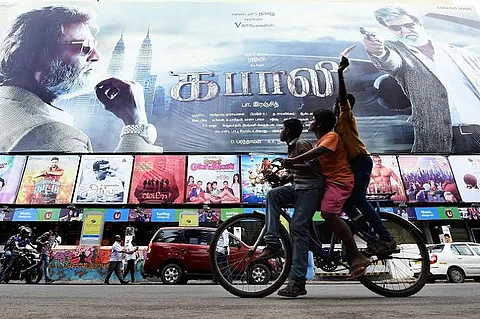

Months after the trailer set fans ablaze with expectation, the “Kabali” juggernaut is finally here. Udta Tamil Nadu. Elsewhere in the country, another video has set people ablaze – not with expectation but with defiance. I speak of the public flogging of four dalit men who were involved in the cattle trade in Gujarat. A curious and ingenious form of protest has broken out across the state with protestors strewing the carcasses of cows in government offices and public places, challenging the upper caste gau rakshak mob to clean up if they wish to. Do you hear that rumble? Do you hear that voice that speaks up despite the hundred hands that seek to strangle it? It’s been coming for a while now and it is coming hard and strong…why it’s even coming out of the Superstar!
In his first shot, “Kabali” (Rajinikanth) is seen reading “My Father Baliah”, YB Satyanarayana’s powerful family biography that traces the struggles of his dalit family over the years and changing times. As in “Madras”, Pa.Ranjith gently nudges us towards dalit literature, towards texts that speak of the unspeakable. If it must take a Superstar recommendation for us to finally pick up and read those voices, why not? I’m usually not a fan of pushing ideology through film but questioning oppression, fighting for the downtrodden and breaking feudal hierarchies are already Thalaivar tropes, so the politics isn’t new – it just has more context, it’s just bolder than it ever was. It has a name.
Standing by itself, “Kabali” is a lukewarm gangster film – there are rushed scenes about illegal trade, trafficking, shoot-outs and “I-will-take-revenge” dialogues but there isn’t much intelligence or depth involved in the mob violence or its trajectory. There are barely any chessboard moves, not much of outwitting the other party, not enough surprises. But there is Rajinikanth. Appearing in a salt and pepper avatar that had turned his loyal fan following crazy months before the release of the film, he fills every frame with his swag. The old boy’s still got it and it’s better than ever before when he plays his age. Unless you’ve been living under a rock, you should know by now that the Thalaivar plays the role of an aged don in Malaysia. He walks out of prison to witness the ruins of what was once his empire. His memories are painful. His people – the Tamils – are still suffering, denied equal opportunities and caught in an ugly web of drugs and violence. What’s left for him here?
Revenge, of course. The mobs want blood, there are old debts to be settled, and so it starts all over again. Amidst all this largely mindless violence, Kabali is haunted by the mystery of what happened to his wife, Kumudhavalli (Radhika Apte). Is she dead? How did she die? Who killed her? In an interesting departure from his earlier films where the heroines generally follow the ‘adakkam-odhukkam’ model of womanhood, Kumudhavalli is outspoken and opinionated. She doesn’t just look after the home and the hearth, she is as involved with his political activism. I do wish, though, that Ranjith had spared Apte from reciting that all too familiar dialogue about why she, a fair-skinned woman, fell in a swoon over such a dark-skinned man.
The other significant female character, Yogi (Dhansika), appears to be modelled on Stieg Larsson’s Lisbeth Salander – what with her tattoos, short hair and propensity for violence. But astonishingly, there are no attempts to shame her or turn her into a lady…which is especially refreshing in a Rajinikanth film.
The storytelling is at its best in the scenes between Kabali and Kumudhavalli – the chemistry that they share, the warmth of their relationship, the tenderness in the looks that they exchange, the little gestures of love…all of it works without any dancing around the trees and innuendo-filled duets. Otherwise, though, the film falters and stutters, trying to build suspense and failing, mainly because the villains are so predictable and boringly written. There are sparks in the plot that could have been developed further to really turn it into a film worth the Neruppu da! number but they remain under-explored. If you took Rajini and Santosh Narayanan’s background score off the equation, one can’t help thinking that it would have been a damp squib for the large part.
But despite all its faults, I enjoyed watching “Kabali”. I felt goosebumps rise in my arm when the Superstar explains to an open-mouthed school audience why he wears suits. This is a Rajinikanth film where there’s reason for him to swing one leg over another and sit before his enemies other than the fact that it looks awesome. There is symbolism in the style and it’s one that we’ve seldom seen in celluloid. Ranjith has made a Rajinikanth film (though he’s been denying all along that this is one) but it’s also very much a Ranjith film and it is this marriage of ‘mass’ and back-chat that makes “Kabali” work. The ending is somewhat ambiguous and there’s speculation that there could be a sequel. Will they or won’t they? Will “Kabali” go the Lingaa way or will it live up to the hype at the box-office? Difficult to predict…but for now, I’m in maghizchi to see the marginalized in the mainstream.